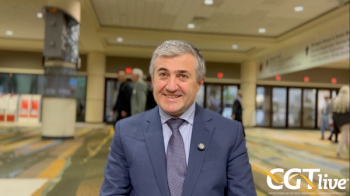
Tisa-Cel Associated With Improved Outcomes at Higher Doses
Higher doses were associated with improved overall survival, event-free survival, and relapse-free survival.
Patients with
Data was collected from records of patients who had been treated at 15 Pediatric Real World CAR Consortium (PRWCC) member institutions and included all patients who were infused and evaluable with commercial tisa-cel with a recorded cell dose. Patients were divided into 4 groups based on dose quartiles for data analysis: 0.134-1.300x106 (D1; n=48 [27%]), 1.301-1.700x106 (D2; n=46 [26%]), 1.701-2.400x106 (D3; n=43 [24%]), and 2.401-5.100x106 (D4; n=43 [24%]).
In the population of 180 patients included in the study, higher doses were associated with improved survival (P = 0.026) in univariate Cox models for OS. Additionally, patients receiving the highest dose range had improved EFS (hazard rate [HR], 0.33 [95% CI,[0.17-0.65]) for highest versus lowest dose group; P = 0.009) in the univariate analysis. With or without censoring for instances of stem cell transplantation, improved RFS was significantly associated with higher dose groups (log-rank P = 0.0045; log-rank P = 0.0019) in the population of 154 responders. Notably, higher
“Further research is warranted to elucidate the relationship between threshold dosing and post-chimeric antigen receptor (CAR) outcomes,” lead author Heather Stefanski, MD, PhD and colleagues noted.1 “Our results however indicate that higher tisa-cel doses associate with superior survival outcomes in the real-world setting and suggest further exploration of higher dosing strategies, within the safe range of tisa-cel, in the clinical setting.”
In the univariate Cox models for OS, the magnitude of effect increased with increasing dose levels (HR, 0.68, CI [0.33-1.38] for D2 versus D1, 0.53 [0.25-1.11] for D3 versus D1, and 0.26 [0.10-0.69] for D4 versus D1) and patients with no detectable disease had improved outcomes compared to patients with high disease burden (HR, 0.18, CI [0.07-0.52]), and patients with low disease burden did as well (HR, 0.30, CI [0.12-0.77]) (P <.001). For the univariate analysis of EFS, patients with no detectable disease had improved outcomes compared to patients with high disease burden (HR, 0.34, CI [0.19-0.60]), as did patients with low disease burden (HR, 0.31, CI [0.16-0.58]) (P <.001). Similarly for univariate analysis of RFS, patients with no detectable disease had improved outcomes compared to patients with high disease burden (HR, 0.44, CI [0.23-0.85]), and patients with low disease burden did as well (HR, 0.33, CI [0.15-0.75]) (P = 0.003).
It was noted that there were associations between higher infused doses and greater CAR T-cell viability (P = 0.02), as well as between higher infused doses and higher percentage of CAR T-cell positive viable cells (P = 0.017). It was also pointed out that there was an association between favorable baseline cytogenetic risk and higher infused doses (P = .002) with 5% of D1 having favorable cytogenetic risk compared to 33% of D4 having favorable cytogenetic risk; however, it was also noted that 43 patients did not have an initial cytogenetic risk recorded. The investigators also assessed the effect of cell dose on initial response at 28 days post-infusion, however no significant association was found in this regard.
The median dose for patients examined in the study was 1.7x106 CAR T cells/kg and the majority received a dose lower than 2x106 cells/kg. Regarding demographics including sex, race/ethnicity, number of prior relapses, indication (refractory or relapse), number of lines of therapy prior to CAR T-cell, prior CD19 directed therapy, prior stem cell transplant, pre-infusion disease burden, and months from initial diagnosis to infusion, no significant differences between dose quartiles were found. However, it was noted that patients who were younger at the time of both diagnosis and infusion received higher doses than older patients (P <0.001), and males had significantly better OS (HR, 0.51 [CI 0.29-0.91] for male versus female; P = 0.021) in the univariate Cox model of OS and EFS (HR, 0.66 [CI 0.43-1.00]; P = 0.049) in the univariate model of EFS.
“The dose groups compared in our current study were based on dose quartiles generated to interrogate patterns of association between dose and outcomes, not to identify an optimal dose threshold or dose range,” Stefanksi and colleagues added, pointing out a limitation of their research.1 “In the higher dose quartiles, there were improved cytogenetics compared to lower doses which potentially could have affected the ability to collect appropriate T-cells for CAR-T generation and could also have served as a confounder in our data set. Thus, the impact of cytogenetics on post tisa-cel outcomes needs to be delineated in additional studies.”
Stefanksi and colleagues ultimately concluded that because tisa-cel's package insert currently allows for a broad dose range, their research has implications regarding the potential for targeting of higher doses to optimize for long-lasting remission.
REFERENCE
Stefanski H, Eaton A, Baggott C, et al. Higher doses of tisagenlecleucel associate with improved outcomes: a report from the pediatric real-world CAR consortium. Blood Advances. Published online August 8, 2022. doi.org/10.1182/bloodadvances.2022007246
Newsletter
Stay at the forefront of cutting-edge science with CGT—your direct line to expert insights, breakthrough data, and real-time coverage of the latest advancements in cell and gene therapy.

















































